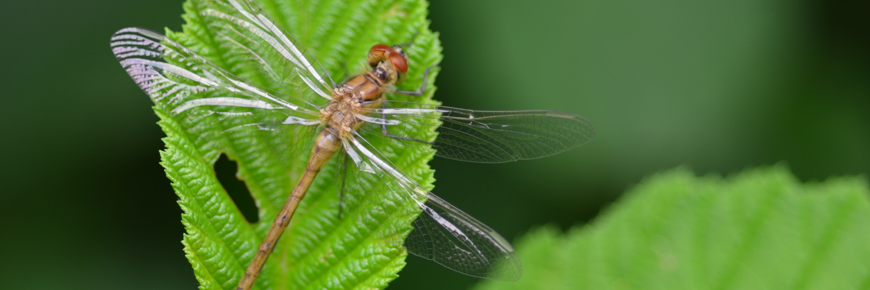
Dragonflies and damselflies
Cape Breton Highlands National Park
You might not think it to look at them, but dragonflies and their smaller cousins, damselflies, are all voracious carnivores. In fact, these two groups of insects are unusual in the insect world because both their larval and adult forms are carnivorous. The larvae are quite large and eat anything that moves in their watery home and is small enough for them to tackle, including other dragonfly larvae, worms and small fish. The adults feed on other insects, including smaller dragonflies, mosquitoes and black flies.
Contrary to popular belief, dragonflies do not bite or sting humans. So next time you are out hiking and a dragonfly hovers in close to you, take a moment to admire its beautiful markings, and thank it for eating the mosquitoes that are eating you.
There are 85 species of dragonflies and damselflies known to be living on Cape Breton Island. Just under half that number (40) are known to live in Cape Breton Highlands National Park. Dragonfly and damselfly larvae can be found in just about any freshwater habitat that is productive enough to feed their appetites, but only certain species will be found in each kind of habitat.
Dragonflies in Cape Breton Highlands National Park
Dragonflies are generally large and often chunkier than their damselfly cousins. When perched, dragonflies don't fold their wings above their backs, but hold them horizontally out on either side of the body. Two kinds of dragonfly you can find in the park are the striped emeralds and the wandering glider.
Striped emeralds
There are around 11 species of striped emeralds in the northern Cape Breton Ecosystem. Five species can be found in Cape Breton Highlands National Park. Striped emeralds are medium to large darkly-coloured dragonflies with metallic highlights and emerald green eyes. Many of them may have yellow markings as well.
The Québec emerald and the incurvate emerald both live in Cape Breton and are the only two species of dragonflies that live in Canada which have been redlisted by the IUCN.
The wandering glider
Wandering gliders are a well-known migratory species of dragonfly. They are known worldwide and have been found 800 kilometres out to sea! It is uncertain whether they complete their life cycle in Cape Breton or are just passing through. Wandering gliders are quite large and breed in temporary ponds and pools. They are golden brown with clear wings, an orange face and golden eyes. They're the only large gold dragonfly you'll see in the park.
Damselflies in Cape Breton Highlands National Park
Damselflies are generally smaller and slimmer than dragonflies, and when perched, they hold their wings together above their backs. Two kinds of damselfly you might encounter in the park are the ebony jewelwing and the bluet.
The ebony jewelwing
Ebony jewelwings live around running streams of all sizes. The female lays her eggs in aquatic vegetation in the stream. She is bronze in colour and has gray wings with white bases. The male is iridescent green with ebony wings. The ebony jewelwing is the most common kind of jewelwing in the region. Jewelwings are the largest kinds of damselflies in northeastern Canada.
Bluets
There are around 6 different species of bluet found in the northern Cape Breton ecosystem. They are the most common blue damselfly you'll see in the park. Most bluets live near slow moving waters. The males are generally sky blue and the females are gray or brown.
- Date modified :